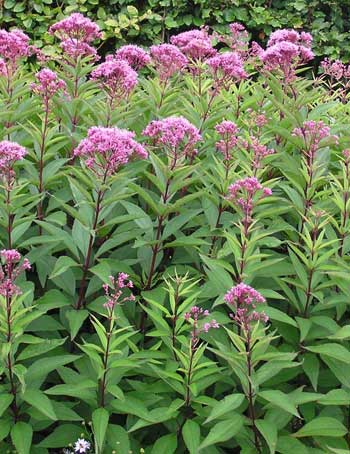Contents:
Common Names | Parts Usually Used | Plant(s) & Culture | Where Found | Medicinal Properties | Biochemical Information
Legends, Myths and Stories | Uses | Formulas or Dosages | Bibliography
Scientific Names

- Eupatorium purpureum L.
- Compositae
- Composite family
Common Names
- Gravel root
- Kidney root
- Lan-ts’ao (Chinese name)
- Queen of the meadow
- Thoroughwort
- Trumpet weed
- Purple boneset
Parts Usually Used
Root, floral decoctions are diuretic and tonic
Back to Top
Description of Plant(s) and Culture
Gravel root is distinguishable by the purple band about 1 inch broad around the leaf point. The perennial plant reaches 5-6 feet, with pail purple to white tubular flowers, in a somewhat rounded cluster, blooms in August and September. The leaves, from 3-5 at the joint, are broad, rough and jagged. The root is the official part, with a fragrance resembling that of old hay, and slightly bitter, aromatic taste which is faintly astringent but not unpleasant.
Back to Top
Where Found
Found in low places, dry woods or meadows in northern, western and middle regions of North America and in Canada.
Back to Top
Medicinal Properties
Diuretic, stimulant, tonic, astringent, relaxant
Back to Top
Biochemical Information
Euparin, which is yellow, neutral and crystalline; eupurpurin is an oleoresin that is precipitated from an alcoholic tincture of the herb.
Back to Top
Legends, Myths and Stories
The name “Queen of the meadow” is shared with a European species (Spiraea ulmaria).
Spotted Joe-Pye weed (Eupatorium maculatum L.) is used similarly but the Native Americans used the root to induce sweating in typhus fever. Boneset (Eupatorium perfoliatum L.) is not the same as Joe-Pye weed, although they share the name boneset in some locations.
The Joe-Pye weed was named after a Native American doctor named Joe Pye who used it medicinally. The medicine man taught early settlers how to use it.
Back to Top
Uses
A good remedy for gravel in the gallbladder, dissolves stones, chronic urinary and kidney disorders, bed wetting, poor appetite, dropsy, neuralgia, rheumatism. Very soothing and will relax the nerves. Increases the flow of urine. Combined with uva ursi, marshmallow, blue cohosh, and lily root, good for female troubles, bladder and kidney infections, diabetes, and Bright’s disease.
Also used for headache, hysteria, impotence, indigestion, intermittent fever, sciatica, sore throat, urine retention, vomiting, asthma, chronic coughs, colds, typhus fever
Back to Top
Formulas or Dosages
Infusion or decoction: take 1 cup every 2 hours for excess uric acid.
Tincture: take 5-15 drops in a cup of water.
Cough syrup: made of the blossoms and leaves, steeped and boiled down, molasses added; then boiled to a syrup.
Back to Top
Bibliography
![]() Back to Eden
Back to Eden, by Jethro Kloss; Back to Eden Publishing Co., Loma Linda, CA 92354, Original copyright 1939, revised edition 1994
![]() Eastern/Central Medicinal Plants
Eastern/Central Medicinal Plants, by Steven Foster and James A. Duke., Houghton Mifflin Company, 215 Park Avenue South, New York, NY 10000
![]() The Herbalist Almanac
The Herbalist Almanac, by Clarence Meyer, Meyerbooks, publisher, PO Box 427, Glenwood, Illinois 60425, copyright 1988, fifth printing, 1994
Herbal Gardening, compiled by The Robison York State Herb Garden, Cornell Plantations, Matthaei Botanical Gardens of the University of Michigan, University of California Botanical Garden, Berkeley., Pantheon Books, Knopf Publishing Group, New York, 1994, first edition
![]() Planetary Herbology
Planetary Herbology, by Michael Tierra, C.A., N.D., O.M.D., Lotus Press, PO Box 325, Twin Lakes. WI 53181., Copyright 1988, published 1992
![]() The Complete Medicinal Herbal
The Complete Medicinal Herbal, by Penelope Ody, Dorling Kindersley, Inc, 232 Madison Avenue, New York, NY 10016, First American Edition, copyright 1993
![]() Indian Herbalogy of North America
Indian Herbalogy of North America, by Alma R. Hutchens, Shambala Publications, Inc., Horticultural Hall, 300 Massachusetts Avenue, Boston, Massachusetts 02115, 1973
 How Indians Use Wild Plants for Food, Medicine & Crafts
How Indians Use Wild Plants for Food, Medicine & Crafts, by Frances Densmore, Dover Publications, Inc., 180 Varick Street, New York, NY 10014, first printed by the United States Government Printing Office, Washington, in 1928, this Dover edition 1974
![]() American Folk Medicine
American Folk Medicine, by Clarence Meyer, Meyerbooks, publisher, PO Box 427, Glenwood, Illinois 60425, 1973
 Secrets of the Chinese Herbalists
Secrets of the Chinese Herbalists, by Richard Lucas, Parker Publishing Company, Inc., West Nyack, NY, 1987.
![]() Webster’s New World Dictionary
Webster’s New World Dictionary, Third College Edition, Victoria Neufeldt, Editor in Chief, New World Dictionaries: A Division of Simon & Schuster, Inc., 15 Columbus Circle, New York, NY 10023
 An Instant Guide to Medicinal Plants
An Instant Guide to Medicinal Plants, by Pamela Forey and Ruth Lindsay, Crescent Books (January 27, 1992).
![]() The Yoga of Herbs: An Ayurvedic Guide to Herbal Medicine
The Yoga of Herbs: An Ayurvedic Guide to Herbal Medicine, by Dr. David Frawley & Dr. Vasant Lad, Lotus Press, Twin Lakes, Wisconsin, Second edition, 1988.
 The Rodale Herb Book: How to Use, Grow, and Buy Nature’s Miracle Plants (An Organic gardening and farming book)
The Rodale Herb Book: How to Use, Grow, and Buy Nature’s Miracle Plants (An Organic gardening and farming book), edited by William H. Hylton, Rodale Press, Inc. Emmaus, PA, 18049., 1974
